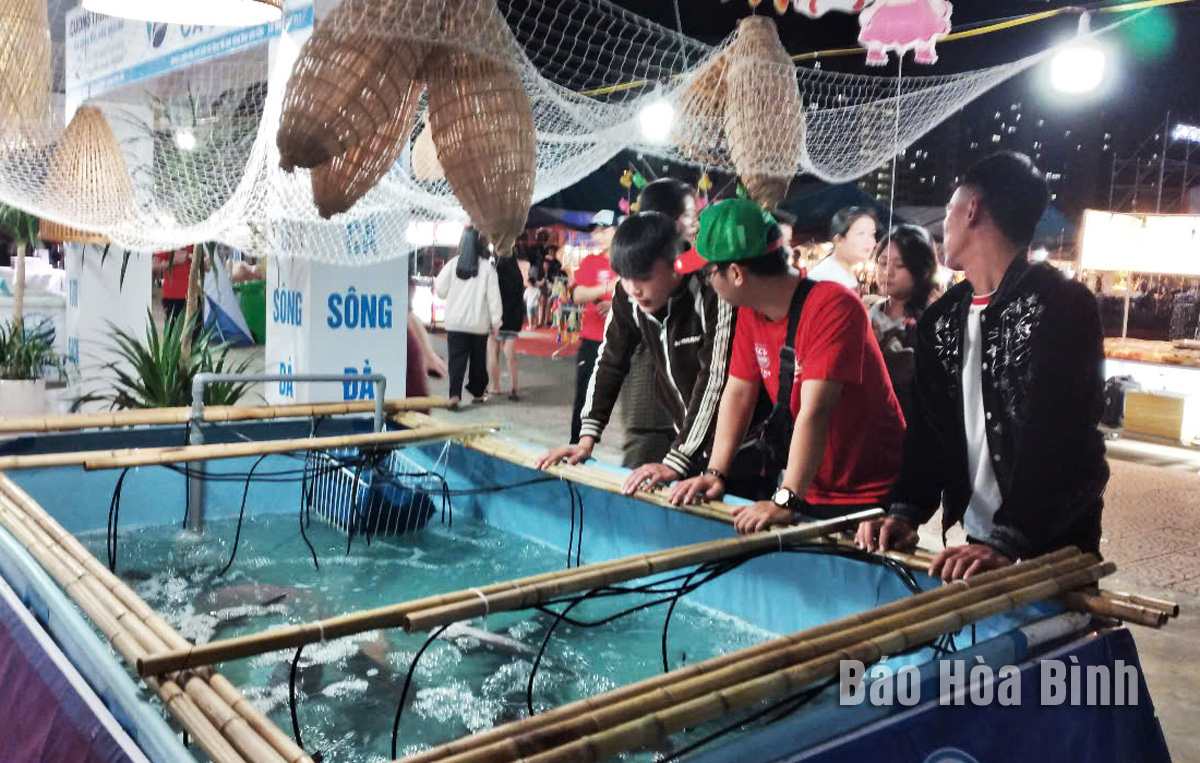
As part of the opening ceremony of the 2024 Hoa Binh Province Da River Fish and Shrimp Festival, the auction of specialty fish from the Hoa Binh reservoir attracted significant attention.
Specialty fish at the ceremony of the 2024 Hoa Binh Province Da River Fish and Shrimp Festival.
Thousands of attendees cheered as bidders
competed for prized catches. A commercial sturgeon weighing over 45 kg from Hai
Dang Aquaculture Co., Ltd. fetched a final price of 150 million VND (60 USD),
while a 25-kg black carp from Cuong Thinh Aquaculture and Services Co., Ltd.
was sold for 105 million VND. Both fish were raised in the Hoa Binh reservoir,
known for its high-quality aquatic products that meet the standards of even the
most discerning consumers.
This marks the second year the festival has been
held at a provincial level, aiming to enhance the value of aquaculture and
develop signature tourism products for Hoa Binh. The opening night drew
thousands of residents and tourists to the province's Exhibition and Trade
Center for shopping, entertainment, and experiences.
Hai Dang Aquaculture Co., Ltd., with over 20
years of aquaculture experience in the Hoa Binh reservoir, showcased its live
specialty fish and shrimp, alongside a variety of processed products. Many of
these items meet 3-star and 4-star OCOP standards.
Recognising the potential of integrating cage
fish farming with tourism, the company has expanded its hands into eco-tourism
services, offering restaurants, accommodations, and professional guided boat
tours. Their efforts aim to attract both domestic and international visitors to
the region, often referred to as the "Halong Bay of the mountains".
The Hoa Binh reservoir area has significant
potential for developing aquaculture alongside eco-tourism, community tourism,
and leisure activities, according to the Department of Agriculture and Rural
Development. The province currently maintains 2,695 hectares of fish farming in
reservoirs and 4,987 fish cages, with an estimated 2024 aquaculture production
of 12,500 tonnes. Fish cage farming on the Da River has become a major
contributor to the agricultural sector's growth.
Efforts to align aquaculture with eco-tourism
are part of a broader initiative to establish the Hoa Binh reservoir as a
National Tourism Area, per Resolution 14-NQ/TU. Presently, the area boasts over
100 lodging facilities employing 1,200 workers, and approximately 300 tourist
transport vehicles. An interconnected network of restaurants, tourist sites,
and lake experiences has created a diverse tourism ecosystem, increasingly
appealing to visitors.
These developments highlight promising
opportunities for local authorities and communities to expand cage fish farming
and tourism, positioning the Hoa Binh reservoir as a leading economic and
tourism hub in Vietnam’s ethnic minority regions.
According to data from the Hoa Binh Provincial Party Committee, the industrial production index for the first six months of 2025 is estimated to have increased by 20% compared to the same period last year. This marks the highest year-on-year growth rate for this period since 2020.
In the first six months of 2025, Hoa Binh province’s export turnover was estimated at 1.145 billion USD, marking an 18.11% increase compared to the same period in 2024. Import turnover was estimated at $ 804 million, a 17.15% increase, which helped the province maintain a positive trade balance.
The lives of the ethnic minority farmers in Tan Lac district have gradually improved thanks to the new directions in agricultural production. This is a testament to the collective strength fostered through the professional associations and groups implemented by various levels of the district’s Farmers’ Union.
With the motto the "product quality comes first,” after nearly one year of establishment and operation, Muong village’s Clean Food Agricultural and Commercial Cooperative, located in Cau Hamlet, Hung Son Commune (Kim Boi district), has launched reputable, high-quality agricultural products to the market that are well-received by consumers. The products such as Muong village’s pork sausage, salt-cured chicken, and salt-cured pork hocks have gradually carved out a place in the market and they are on the path to obtaining the OCOP certification.
In the past, the phrase "bumper harvest, rock-bottom prices" was a familiar refrain for Vietnamese farmers engaged in fragmented, small-scale agriculture. But today, a new spirit is emerging across rural areas of Hoa Binh province - one of collaboration, organisation, and collective economic models that provide a stable foundation for production.
Maintaining growing area codes and packing facility codes in accordance with regulations is a mandatory requirement for agricultural products to be eligible for export. Recently, the Department of Agriculture and Environment of Hoa Binh province has intensified technical supervision of designated farming areas and packing facilities to safeguard the "green passport" that enables its products to access international markets.



